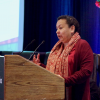Five years ago, Lhoosk’uz Dene Nation in northeastern British Columbia had similar food security problems as many remote First Nations across the country. The community is located 400 kilometers from the closest grocery store, so fresh food was nearly impossible to get.
Sugary and boxed foods were the norm; diabetes in Elders and obesity in children was rampant.
When Lana Koldeweihe looks back at how the community was, she is amazed at how far Lhoosk’uz has come in taking control of its food security.
Koldeweihe is Lhoosk’uz’s community garden coordinator. She has watched the community start gardening literally from the ground up – first building a greenhouse, then clearing the boulders from the garden ground, planting the unsuccessful first crop years ago and helping the garden grow to the point where now vegetables from the garden feed the community all winter long.
She has also watched the effect that the garden and greenhouse has had on the community in terms of building relationships between youth and Elders, bringing the community together and helping promote healthy living to all members.
“If you’re talking about how can we make change in the community, this project has covered both the community’s health and the food security issues,” Koldewiehe told Wawatay. “We’re building community sustainability, and the community members now all have full access to fresh produce.”
Lhoosk’uz is an excellent example of how a community can take the initiative to tackle its food security issues through small-scale gardening and greenhouse projects. But it has not operated in isolation. The community is one of 17 remote First Nations in B.C. that have been part of a provincially-funded program to build sustainable food systems in remote communities. And while the communities have had varying levels of success, overall the program is earning accolades and showing the effectiveness of working together when it comes to community-based programming.
Kerry O’Brien is a director at Context Research Ltd, the company hired by the B.C. government to review the First Nations Food Systems project. Looking back over four years of the program, O’Brien told Wawatay that despite some significant challenges in every community involved in the project, the overall outcomes have been very positive.
“There were a lot of barriers, so communities really had to come together with determination and problem solving to deal with what sometime seemed like insurmountable problems,” O’Brien said.
The program, originally called the Produce Availability in Remote Communities Initiative (PAI), was started in 2008 through a partnership between B.C.’s ministry of health, the provincial agriculture ministry and the Heart and Stroke Foundation.
The goals were quite simple – to improve the year-round availability and quality of fruits and vegetables in remote communities.
But as O’Brien explained, when it came to developing community gardens and greenhouses in communities from scratch, the program had to start from the very beginning.
One of the major challenges O’Brien noted was a lack of education around healthy eating, growing food and where food comes from.
“It took two years in some communities before the community members started to prioritize working in the community garden, when they realized the benefits of growing their own food,” O’Brien said.
There were many other physical barriers as well, from a lack of good soil in some communities to severe weather restrictions and short growing seasons in others.
However, now in the fifth year of the program, nearly every community involved in the program has a thriving garden of its own, and over half of the communities have at least one greenhouse. Many of those gardens are being run by a combination of Elders and children in the communities, and nearly all members of the communities are receiving large amounts of fresh fruits and vegetables when the autumn harvest is completed.
O’Brien said that for other jurisdictions looking to implement a similar project, a five-year funding model should be used to give the project proponents time to set up a solid foundation in the communities. She also highlighted another successful component – having at least one paid community garden coordinator in each community to coordinate the garden and work at it year-round.
In the end, O’Brien is confident that other provinces and remote regions of the north can have success with similar type projects, so long as local communities are involved in setting them up and helping to develop them. The challenges of geography and climate faced by the northern B.C. First Nations are as extreme as nearly any place in the country, she said, and yet communities such as Lhoosk’uz have shown that building a small-scale food system from the ground up is possible and beneficial, on a number of different levels.
For Koldeweihe, as her community gets set to build a second greenhouse and continue expanding its community garden, the future of growing food in Lhoosk’uz is very positive.
“Each year we’ve incorporated materials into the school system to educate the kids, and in the second year we started bringing the healthy produce into the school lunch program,” Koldeweihe said. “Now the kids are taking the vegetables home and encouraging their parents to cook it.
“We’re building community sustainability,” Koldeweihe added. “The members now have full access to fresh produce, and people seem to be taking to it. They’re more excited by the garden now that they’re seeing a lot of the benefits of growing our own food.”
Gold has arrived.












Gold has arrived. Here in the north of Ontario we see vast streams of gold shimmering across the landscape as autumn is here and the the leaves are turning...
I am the product, evolution of many thousands of years as are you. I grew up on the land in the remote far north of Ontario following in the footsteps of my...